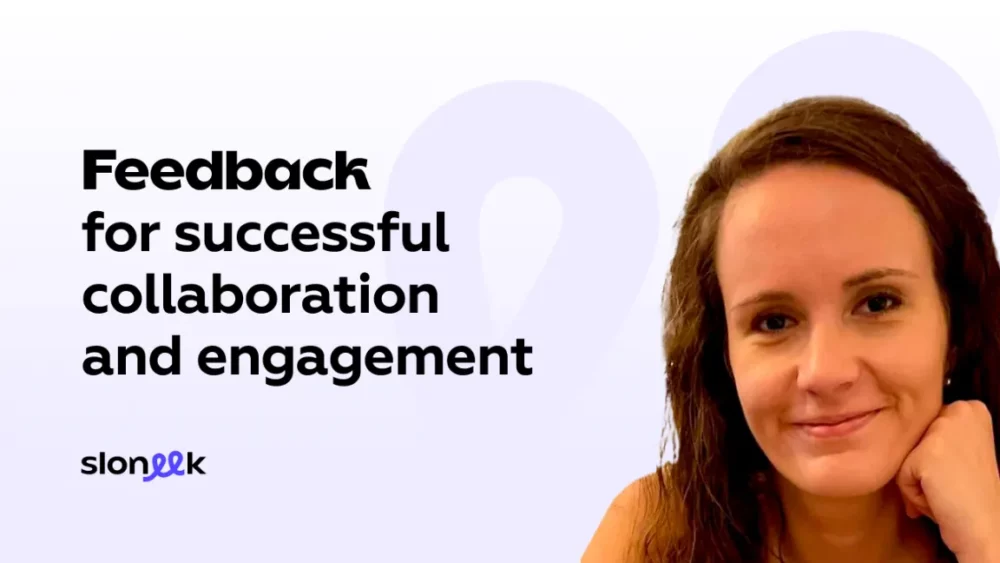Feedback for Successful Collaboration and Engagement

Feedback is a topic that almost every employee and manager has heard of. Yet, in practice, we still find that it doesn’t work as it should. It can be seen as a necessary evil, an unwanted blocker in the calendar, or something that is only mentioned once a year during a performance review. However, it is an incredibly powerful tool that costs almost nothing (mutual time) and has a huge impact on the success of collaboration and people’s engagement. You just need to use it correctly and regularly.
We Don’t Operate in Silos
In work and in life, we never operate alone—we are connected to colleagues, managers, clients, family, and so on. To collaborate effectively, we need to be aligned and aware of each other. Feedback provides us with “guardrails for behavior”—a clear signal of how our actions affect others and what the other party needs from us. The problem arises when feedback is limited to criticism or is not given at all. This creates silence, uncertainty, and frustration. We don’t know if we are doing our job well and often create negative assumptions. As a result, engagement can gradually decline.
How Our Brain Reacts to Feedback
Receiving feedback is not easy for humans. Evolutionary neurobiology explains that the brain perceives criticism as a threat of exclusion from the group—a subliminal signal that “I’m making mistakes” and “they won’t like me.” People often become defensive. We perceive feedback as an attack on our personality instead of taking it as information about specific behavior.
However, if feedback is given regularly and consistently, the nervous system gets used to it. An employee knows that a regular meeting with their manager isn’t a summons to be reprimanded, but a normal process where both successes and failures are discussed, along with opportunities for improvement.
Two Types of Company Environments
- An Environment of Silence and Fear
People are afraid to speak up.
Feedback comes only as criticism or not at all.
Consequences: frustration, decreased motivation, weaker collaboration.
Physical and psychological impacts: stress, fatigue, risk of burnout. - An Environment of Growth and Openness
Feedback is seen as a learning tool.
Openness, willingness to listen as well as to speak.
Consequences: higher engagement, responsibility, and team cohesion.
Psychological and Health Impacts
A lack of feedback, or poor feedback, has significant consequences:
- Psychological: Loss of certainty (“Am I doing this right?”), a decline in motivation (“No one noticed, so why bother?”), frustration, apathy, loss of trust.
- Health: Chronic stress, sleep problems, a weakened immune system, risk of burnout.
Conversely, positive and constructive feedback leads to greater resilience, joy at work, and long-term engagement.
What Feedback That Drives Progress and Engagement Looks Like
- Regular – Ideally, 1-on-1 meetings at least every two weeks.
- Specific – For example, the SBI (Situation – Behavior – Impact) technique helps describe the situation, the behavior, and its effect.
- Focused on behavior, not personality – Instead of “you are passive,” say “at the meeting, you didn’t bring the proposal we had agreed on.”
- Respectful – It gives space to process emotions and doesn’t demand an immediate reaction.
- Two-way – The manager gives feedback, but the employee also has the right (and responsibility) to say what’s on their mind. The same applies to colleagues (peers) or anyone you collaborate with.

Giving and Receiving Feedback
Much is said about how to give feedback, but it’s rarely mentioned that there is another side that receives it. For any behavioral change to occur, it is necessary to:
- Understand that every person is an individual—with their own mindset, attitudes, opinions, perceptions, and level of emotional regulation.
- If you are in the role of giving feedback, you must realize what the other person is like and adapt your approach accordingly.
- Both of you must be open to feedback; otherwise, it won’t work. You need to have an established relationship—at least on a professional level. You don’t have to be friends who go out for a beer.
- It’s important to listen actively. The goal of feedback is not only to identify what works and what doesn’t but also for the other party to understand it.
- If you need time to process, that’s okay, just ask for it.
- Both parties have the right to say what’s bothering them. It’s not a one-way street.
- Realize that change doesn’t happen overnight. It’s a process that takes time. But it’s essential to talk about things. Otherwise, nothing will happen.
Timing is Important
If you want to tell someone something, it’s best not to put it off until the end-of-year performance review. Likewise, you probably shouldn’t bring it up in front of the whole team during a meeting.
- Talk about things as soon as possible. If someone is doing something differently than they should, it’s important to say so sooner rather than later. Don’t postpone it.
- At the same time, there are situations when you have to postpone it. For example, the person you want to talk to is currently going through personal problems—like a breakup, a death in the family, and so on. If it’s in your power, offer them support rather than criticism in that moment.
Tip: If someone’s performance or behavior suddenly changes, first check if there’s something going on that might be affecting it. You might be able to help them and strengthen your relationship through support. But don’t push it.
How to Change the Company Mindset and Create a Space for Open Conversation
- Build relationships – based on trust, respect, and psychological safety. Then, even feedback will be a bit easier.
- Ensure regularity – feedback is not a project, but a process. You don’t have to meet every day. But, for example, you can manage it once every two weeks. You don’t always have to give formal feedback; you can just have a calm chat about how you’re doing.
- Support from both sides – managers and employees learn not only to give feedback but also to actively seek and receive it. Both must be open to talking about things; otherwise, it won’t work.
- Perceive it as a mutual tool for growth, not control.
Feedback as a Long-Term Investment
Feedback is a valuable tool that we all have at our immediate disposal. We just need to learn to use it correctly and build relationships around us where we can speak openly. It doesn’t cost much—so why not use it?
If you don’t know how, there are many books that can help you get oriented, such as Radical Candor or Thanks for the Feedback. You can also invest in your own development and have a mentor/coach on hand to guide you through feedback and teach you tips on how to do it right. It’s also important that you learn to be open to receiving feedback. We all make mistakes, and it’s good to at least reflect on them and decide if you want to change or not.
Conclusion – How Should You Use Feedback for Employee Engagement
Feedback is not just a tool for improving performance, but above all, a key element that shapes employee engagement. Where feedback is given regularly, openly, and with respect, an environment of trust and growth emerges. People know what is expected of them, feel valued, and have space to move forward. This directly strengthens their motivation, responsibility, and willingness to actively contribute to the success of the team and the entire company.
Conversely, where feedback is lacking or delivered insensitively, it leads to uncertainty, loss of motivation, and a gradual disengagement of people from their work. Engagement is not an accident—it is the result of a conscious approach from leadership and a culture that gives feedback its proper place.
So, if you want your employees to be engaged, loyal, and satisfied in the long term, you must learn to work with feedback as an investment in their development and in the healthy functioning of the entire organization.




